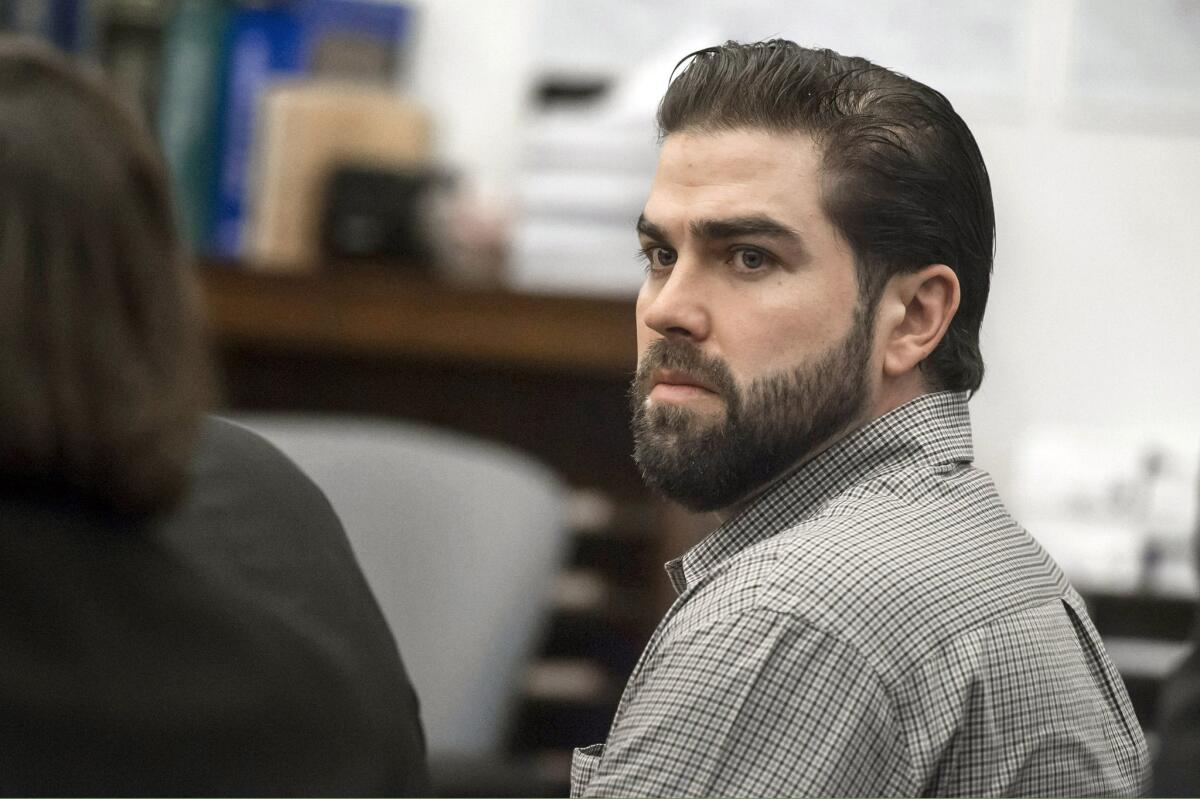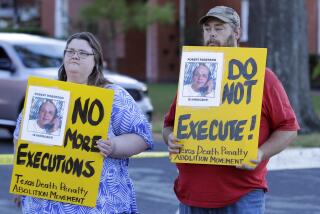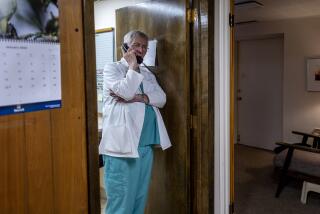Actor who beheaded war veteran faces long road to execution chamber

Daniel Wozniak listens to closing arguments during the penalty phase of his trial in Santa Ana on Monday.
- Share via
Steve Herr assumes he won’t live to see the execution of the man convicted of murdering and then decapitating his son in the attic of an Orange County theater.
“Realistically, I’m not going to be around when he’s put to death,” Herr, 67, said a few days after a jury recommended the death penalty for Daniel Wozniak. “I’ll be dead.”
Orange County Superior Court Judge John Conley is scheduled in March to render the official sentence for Wozniak, 31, for the shooting and beheading of 26-year-old Army veteran Sam Herr and his friend Juri “Julie” Kibuishi, 23, in May 2010.
Wozniak, a community theater actor from Costa Mesa, was desperate for money to fund his upcoming wedding, so he killed the two as part of a plan to steal $62,000 from Herr’s bank account, according to prosecutors.
After his conviction last month, jurors took less than an hour of deliberation Monday to decide that Wozniak deserved death for the murders. Orange County Dist. Atty. Tony Rackauckas said it was the fastest decision on capital punishment he could recall.
Wozniak’s case took more than five years to go to trial, and despite the jury’s decisiveness, its death sentence verdict is just the beginning of another long process that may or may not end with Wozniak’s execution.
In California, where capital punishment has been on hold for a decade, it’s an open question whether convicts sent to death row today will ever have their sentence carried out.
The state put a moratorium on the death penalty in 2006 when a judge ruled that a three-drug lethal injection could cause inhumane suffering.
See more of our top stories on Facebook >>
In November, officials unveiled a one-drug injection that could restart executions, but the method still faces months of public vetting and possible legal challenges.
Even before the moratorium, however, “the reality in California is that, of those who are sentenced to death, very few have been executed and it’s taken an enormously long time,” said Erwin Chemerinsky, dean of the UC Irvine law school.
Since the death penalty was reinstated in California in 1977, juries have sent 900 inmates to death row and 13 have been put to death, according to court papers written by Judge Cormac Carney of the U.S. District Court in Orange County.
On average, there is a 25-year delay between a death sentence being handed down and it being carried out, and that gap is getting longer, according to the judge.
Many factors add up to the decades of lag time between a death sentence and an execution, according to Chemerinsky.
To begin with, all death sentences in California are automatically appealed.
Before any work can be done on the case, a lawyer must be appointed. That in itself can take years.
A 2004 report commissioned by the California Legislature blamed that on budget cuts at the state public defender’s office and on a low rate of pay offered to private attorneys willing to take the assignments.
NEWSLETTER: Get the day’s top headlines from Times Editor Davan Maharaj >>
Another factor is that all such appeals go directly to California’s Supreme Court, which hears only about 20 to 25 such cases a year, according to Carney.
After years of reviewing and briefing their cases, attorneys might wait two to three more years before the court has time to hear their arguments, the judge wrote.
Inmates who lose their appeal to the Supreme Court can appeal again for the court’s consideration. If those appeals are exhausted, inmates can petition a federal court for review, further extending the process.
More condemned inmates die of natural causes than are put to death, according to California Department of Corrections figures that Carney cited in his decision.
“As for the random few for whom execution does become a reality, they will have languished for so long on death row that their execution will serve no retributive or deterrent purpose and will be arbitrary,” Carney wrote.
But such arguments and the death penalty’s murky future did not deter the Orange County district attorney’s office from pursuing capital punishment for Wozniak.
“Cases like this are a perfect example of why the death penalty is appropriate,” Senior Deputy Dist. Atty. Matt Murphy said in a news conference after the jury’s decision.
Prosecutors in Orange County seek capital punishment on only about 4% of eligible cases, but the brutality of Wozniak’s crimes called out for the highest available penalty, Murphy said.
During the trial, jurors heard testimony that Wozniak dismembered Herr’s body before tossing some of the parts in a Long Beach park in a failed attempt to throw police off his trail.
To further the coverup, Wozniak used Herr’s phone to lure Kibuishi to Herr’s apartment, then killed her and staged her body to make it seem as if Herr had raped her and fled, according to Murphy.
Jeremiah Dobruck writes for Times Community News.
ALSO
Man found dead after apparent home invasion in Downey; two arrested
Military-grade explosive device found in backyard of Topanga Canyon home
Explosion risk stalls plan to capture and burn gas from Porter Ranch leak
More to Read
Sign up for Essential California
The most important California stories and recommendations in your inbox every morning.
You may occasionally receive promotional content from the Los Angeles Times.











